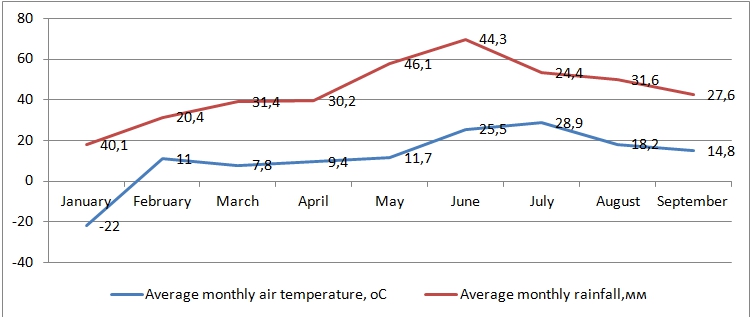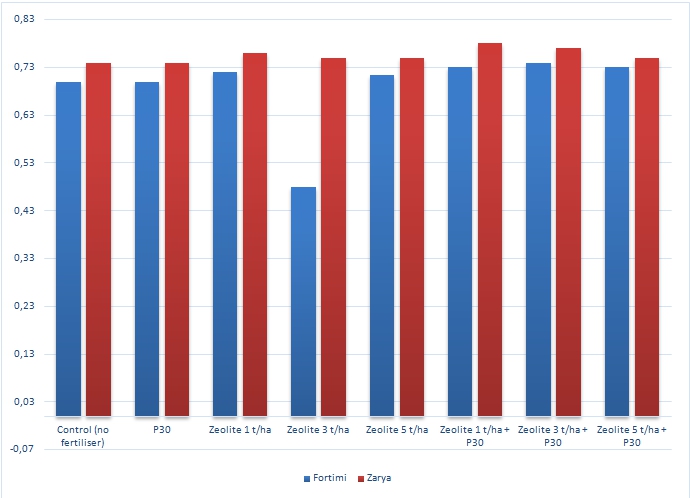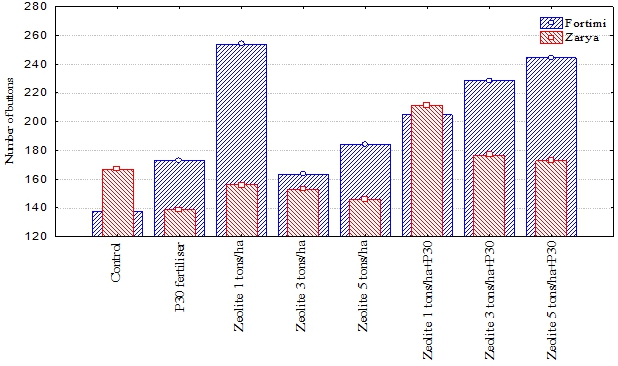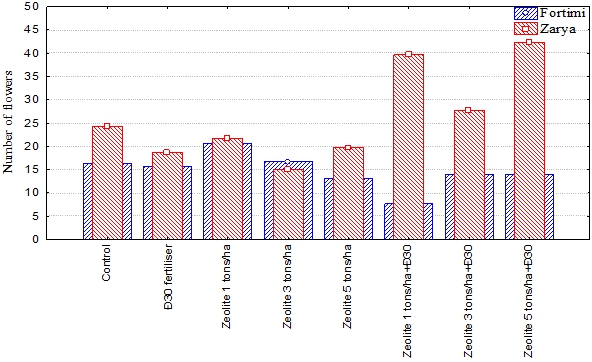INFLUENCE OF NATURAL ZEOLITES AND IMPROVED MINERAL FEEDING ON PHYSIOLOGICAL AND MORPHOLOGICAL FEATURES OF SUNFLOWER IN NORTH-EASTERN KAZAKHSTAN
Кульжанова С.1, Попов В.2
1ORCID: 0000-0001-6662-886X, Кандидат географических наук,
Казахский агротехнический университет им. С.С.Сейфуллина, Астана, Казахстан;
2ORCID: 0000-0001-9252-9427, Профессор, доктор,
Сельскохозяйственный университет Пловдива, Пловдив, Болгария
ВЛИЯНИЕ ПРИРОДНЫХ ЦЕОЛИТОВ НА УЛУЧШЕНИЕ МИНЕРАЛЬНОГО ПИТАНИЯ И НА ФИЗИОЛОГИЧЕСКИЕ И МОРФОЛОГИЧЕСКИЕ ОСОБЕННОСТИ ПОДСОЛНЕЧНИКА В СЕВЕРО-ВОСТОЧНОМ КАЗАХСТАНЕ
Аннотация
Ученые и практические работники для производства безопасных продуктов проводят поиск эффективного и недорогого минерального питания основных полевых культур, адаптированных к изменениям климата. Изучено влияние природных цеолитов и их сочетания с минеральными удобрениями, т.е. суперфосфатом на основе фосфора (Р), на развитие подсолнечника в агроэкологических условиях Северо-Восточного Казахстана. Проведен двухлетний полевой эксперимент в Успенском районе Павлодарской области на подсолнечнике сортов Fortimi (гибрид) и Zarya. Установлено, что добавление природных цеолитов (дозы 1,3 и 5 т/га) и их комбинации с Р-удобрениями в почве привело к увеличению у растений таких показателей как площадь листьев, активность фотосинтеза, чистая продуктивность фотосинтеза. Это способствовало образованию большего количества корзинок у гибрида Fortimi, а у сорта Zarya большего количества цветов, в конечном итоге увеличивая урожайность культуры.
Ключевые слова: природные цеолиты, минеральные удобрения, сорта и гибриды подсолнечника, урожай.
Kulzhanova S.1, Popov V.2
1ORCID: 0000-0001-6662-886X, PhD in Geography,
S.Seifullin Kazakh Agrotechnical University, Astana, Kazakhstan;
2ORCID: 0000-0001-9252-9427, Professor, PhD,
Agricultural University of Plovdiv, Plovdiv, Bulgaria
INFLUENCE OF NATURAL ZEOLITES AND IMPROVED MINERAL FEEDING ON PHYSIOLOGICAL AND MORPHOLOGICAL FEATURES OF SUNFLOWER IN NORTH-EASTERN KAZAKHSTAN
Abstract
In order to adapt to climate changes and produce safe crops, scientists and practitioners are searching for efficient and inexpensive mineral feeding of major crops. This study investigated the influence of natural zeolites and their combinations with mineral fertilizers, i.e. superphosphate on the base of phosphorus (P), on sunflower development under agroecological conditions of North-eastern Kazakhstan. It employed a two-year field experiment in the Uspensky district, Pavlodar region, which was based on a randomized complete block (RCB) with three replicates and eight treatments (variants) using sunflower varieties Fortimi (hybrid) and Zarya. Variants with addition of zeolites and their combinations with P-fertilisers in soil led to realization of a higher photosynthetic potential of sunflower plants compared to control (untreated) variants. They stimulated leaf developments, photosynthetic activity and net photosynthetic productivity. All these in turn produced more sunflower buttons by Fortimi hybrid variety and more flowers by Zarya variety. Therefore, higher yields should be anticipated from from farmers when use both varieties and upon treatments with single doses of zeolites 1, 3 and 5 t/ha and all combinations with superphosphate.
Keywords: natural zeolites, mineral fertilizers, varieties and hybrids of sunflower, yield.
Introduction
The sunflower is one of the most economically-important plants in Kazakhstan [4, P. 3]. It provides the population with vegetable oil and livestock with high-protein fodder. The plant is demanding for soils, the best of which are sandy loamy black-earth, rich in soil nutrients. Good preceding crops in the rotations in temperate zone are spring barley, winter wheat, corn and legumes. The sunflower should not be grown in the same place in 7-9 years. The sunflower responds well to fertilizer application. The most dangerous pests for the plant are wireworms, beetle-keeper and sunflower barbel. Against pests and diseases (white rot and rust) farmers may apply agrotechnical, chemical, mechanical practices. In the arid zones, producers should target sunflower with large leaf area and more reproductive organs. In many studies [5, P. 3463, 3464]; [7, Р. 87] natural zeolites are reported to provide essential micro- and macro-elements thus increasing the efficiency of mineral fertilisers.Due to the great economic benefits, areas under sunflower are constantly growing. Over the past 10 years, they have increased 5 times and reached almost 1 million hectares in Kazakhstan. In recent years, sunflower varieties of Russian origin were widely distributed such as Zarya, Voskhod, Siberian 91, Skorospel 87. Therefore, this study aimed to identify highly productive hybrids adapted for cultivation in the conditions of the Pavlodar region, Northern Kazakhstan, based on improved morphological and physiological parameters of plants.
Materials and methods
Region of study
The average annual temperatures in the region are between 1 and 3ºC, in the north are about 0ºC, in the mid-country about 1.8ºC, and in the south -2.5oC. The average monthly temperatures of the warmest month of July are between 19ºC to 21.3ºC. Often, in the summer months the heat reaches 40ºС and above. The average temperature of the coldest month of January varies in the region between 17ºC to -18.1ºC. There are 70-80 days with frosts below -20ºC per year and 25-30 days below -30ºС. Precipitation during the study years was unevenly distributed during the growing season. During the winter months (January, February), the amount of rainfall was at the level of average annual indicators during the period of research, in spring months (March, April, May) - by 6.5-11.7 mm more, in the summer months - by 3.2 -13.2 mm more (Fig. 1). Calculations of the hydrothermal coefficient, carried out on the basis of the prevailing temperature regime and the amount of precipitation during the vegetation period, characterized the meteorological conditions of 2015 as slightly arid (GTK = 0.80), 2016 as moderately arid (GTK = 0.82). Thus, the bioclimatic indicators showed that the temperature regime during the study was at its long-term average and moisture regime was at its average also. The bioclimatic potential was 1.39, or 74 points, which corresponds to a lower level of biological productivity of the region. The hydrothermal coefficient was 0.65, which corresponds to the average level of aridity.
Fig. 1 – Climate data of the major parameters
Zeolites and fertilization
The research was carried out on the basis of JSC "Kazakh Agrotechnical University named after S.Seifullin". The research was carried out using the natural zeolite of the Kazakhstan deposit. The rate of application depended on the task, from 1 to 5 tons / ha. Phosphate fertilizers in the form of superphosphate of a simple dose of fertilizer were used in the study according to the generally accepted method in dependence on the availability in the soil. Fertilizers were introduced by sowing crops. Repeat three times with repetition in time. Terms of sowing were carried out in the farm recommended from May 10, with a seeding rate of 6,500 seeds per 1 ha.
Parameters investigated
Field investigations included sampling of plants per variant in three replications every 40, 60 and 80 days from sprouting and prior to harvesting. Parameters of growth were determined by following methodology:
- Photosynthetic activity – determined by calculating photosynthetic yield Y(II) by measuring chlorophyl fluorescence. The fluorescence was measuring by fluorimeter MINI-PAM YeinzWalz GmbH (Germany). Potential quantum yield upon photochemical transformation of energy can be calculated by formulae of Genty et al. (1989): YIELD= (Fm'-F)/Fm' = ΔF/ Fm'.
- Net photosynthetic productivity – by Nichiporovich A.A. et al. [1, P. 16]
NFP = (В2 - В1) / (Л1 + Л2) ´ 0,5х n
where NFP – Net photosynthetic productivity g/м2/day; В1andВ2 – dry plant biomass in the beginning and at the end of study period, in g.;Л1 and Л2 – leaf area in the beginning and at the end of study period, in м2; n – period between two measurements, in days.
The results of the study were subjected to mathematical processing using the software of StatSoft Inc., Microsoft Inc. and by employing multifactorial dispersion Analysis of Variance (ANOVA).
Research results
Photosynthetic activity
The average values of photosynthetic activity (Fig. 2) are in the range of 0.80-0.83. Photosynthetic activity in the Fortimi variety reached 0.74, in the Zarya variety up to 0.78. The highest rates were for variants with the introduction of zeolite 1-3-5 tons per 1 ha + P30.
Fig. 2 – Photosynthetic activity of sunflower leaves in relation to variant (treatment) with zeolites
The net productivity of photosynthesis (NPP) in the average year of 2015 and 2016 was 101.89 g / m2 / day for Fortimi and 98.95 g / m2 / day for Zarya (Table 1). This can be attributed to moisture availability. Good indices were obtained from the Fortimi variety in all variants upon application of zeolite 3 tons / ha and with the addition of combinations of 1 and 3 tons / ha + P30. Zarya variety was more responsive upon application of combinations of zeolite 3 and 5 tons / ha + P30.
Table 1 – Net photosynthetic productivity, depending on the application rate of the zeolite, g / m2 day
| Variant | Fortimi | Zarya | ||
| 2015 | 2016 | 2015 | 2016 | |
| Control | 86,26a | 27,30a | 18,62a | 52,94a |
| Р30 | 73,41a | 64,40b | 109,73b | 58,85a |
| Zeolite 1 t/ha | 70,29a | 107,51c | 113,41b | 79,71b |
| Zeolite 3 t/ha | 163,66b | 144,83d | 127,17c | 68,86b |
| Zeolite 5 t/ha | 117,75c | 68,50b | 107,04b | 81,64bc |
| Zeolite 1 t/ha + Р30 | 108,92c | 167,84e | 60,81d | 92,38c |
| Zeolite 3 t/ha + Р30 | 135,17d | 146,29d | 115,36bc | 116,39d |
| Zeolite 5 t/ha + Р30 | 59,74e | 96,61c | 139,46c | 102,07cd |
Note: *Different letters show statistically significant differences between means (Duncan multiple range test, at p<0.05) of each variant within one year of investigation Number of buttons and flowers.
The ANOVA (at p <0.05) showed that the Fortimi variety had higher number of baskets than the control variant and compared to the Zarya variety(Fig. 3). High results were shown from the Fortimi variety upon application of zeolite 1-3 and 5 tons / ha + P30, while by Zarya variety upon application of 1 ton of zeolite per 1 ha + P30.
Fig. 3 – The influence of major factors Variant and Variety on the number of sunflower baskets
The ANOVA (at p<0.05) showed that after comparing all variants, the Zarya variety had more flowers compared to the control variant and compared to the Fortimi variety (Fig. 4). The effect was more profound after application of combinations of zeolite 1 ton, 3 tons and 5 tons + P30 (Fig.4).
Fig. 4 – The influence of the interaction of different factors on the number of sunflower flowers
Discussion
The zeolite fertilization stimulates plant growth, i.e. physiological and morphological features. It is, however, variety-specific. Overall, combinations of zeolites and P-fertilizers stimulate leaf developments and photosynthetic potential. For instance, the Zarya variety showed a higher photosynthetic activity compared to the control (untreated with zeolite) variant and compared to Fortimi variety. But Fortimi showed a higher net productivity of photosynthesis after application of single dose of zeolite 3 t/ha and after application of combinations of zeolite 1 t/ha+Р30 and zeolite 3 t/ha+Р30, while Zarya showed a high net productivity of photosynthesis after application of Zeolite 1 and 3 t/ha and Zeolite 1, 3 and 5 t/ha+Р30. The results confirms Nichiporovich A.A. [1, P 16], who emphasizes the net photosynthetic productivity (NPP) as an indicator for plant productivity. He argues that the NPP shows the ratio between yield of all plants (in grams) and plant leaf area (in m2), which ‘works’ for certain period of time. In most cases, values of this parameter vary between 5 and 6 to 10 to 12 g dry matter on 1 m2 leaf area per day. But depending on environment conditions, it may change, sometimes even close to zero. This study showed that NPP changes as a result of changed mineral feeding and changed moisture during vegetation period, i.e. maximum NPP values during active sunflower growing (i.e. phenophase ‘2-4 leaf – formation of buttons – flowering’, as an average of 2 years, was superiour by Fortimi compared to all variants of Zarya. The study of NPP dynamics showed that accumulation of dry matter on a unit of assimilation apparatus of plants is most intensive starting from phenophase of 2-4 leaf until formation of buttons. Further, i.e. in the period from flowering to maturing, the NPP decreases. Therefore, formation of yield in the period of active growth depends on essentially on photosynthetic activity of plants, but during plant generative period the reutilization of plastic substances prevails. Interestingly, the physiological responses reflected in morphological changes, i.e. a good workability of leaf apparatus realized a good photosynthetic potential of sunflower plants from both varieties. As a result, Fortimi produced more buttons, but Zarya more flowers per total plants.
The use of zeolites in combination with P mineral fertilizers had a positive effect on the growth and development of plants, which confirms Suzer S. [8, P. 123], Darby H. [2, P, 12], Pond W.G. [9, P, 96]. Soil climatic conditions also had their impact, especially the provision of moisture prior to sowing. These factors had a positive effect on the increase in the yield of the sunflower. The Zarya variety showed an overall better area of leaves, more flowers and baskets, and also seeds compared to control (untreated with zeolite) variant after application of 1, 3 and 5 tons per 1 ha +P30. It can be generally concluded that Zarya is slightly more adapted to the climate conditions that has developed in the region and response well to the used non-traditional type of fertilizer (i.e. zeoilite + mineral P-fertilizer).
Conclusions
The use of natural zeolites in combination with mineral fertilizers such as phosphorus fertilizer, has a favorable effect for adaptation to the changing climate conditions and for a growth and development of productive sunflower plants. Combinations of zeolites and P-fertilizers stimulated leaf developments and photosynthetic potential of sunflower plants as they showed higher photosynthetic activity and net photosynthetic productivity. All these in turn produced more sunflower buttons by Fortimi hybrid variety and more flowers by Zarya variety. Therefore, higher yields should be anticipated from both varieties after treatments with single doses of zeolites and their combinations with P-fertilizers.
Список литературы / References
- Ничипорович А.А. Фотосинтетическая деятельность растений, как основа их продуктивности в биосфере и земледелии / А.А. Ничипорович – М.: Наука, 1988 – 125 с.
- Darby H. Sunflower Research Trials / H. Darby, R. Madden, A. Gervais and others. – Burlington: University of Vermont, 2009. – 16 p.
- Колягин Ю. С. Урожайность семян подсолнечника при совместном действии природных цеолитов и удобрений / Колягин Ю. С., Хаустов А.Н. // Достижения аграрной науки в начале XXI века: материалы научно и учебно-методической конф. 1 января-31 декабря 2002 г., Воронеж / М-во образования и науки Рос. Федерации, Федер. гос. бюджет. образоват. учреждение высш. образования «Воронежский гос. аграрный ун-т им. Императора Петра I». – Воронеж, 2002. – С. 188-191.
- Каскарбаев Ж. Ресурсосберегающая технология возделывания подсолнечника для масличных культур: рекомендации / Ж. Каскарбаев, Ю. Похоруков., А. Кыдыралина – Шортанды, 2011 – 65 с.
- Mumpton F. A. La roca magica: Uses of natural zeolites in agriculture and industry / Natl. Acad. Sci. USA. Colloquium Paper // - 1999 - Vol.96 - P. 3463–3470.
- Oshundiya F.O. Seed yield and quality of sunflower (Helianthus annuus L.) as influenced by staggered sowing and organic fertilizer application in the humid tropics / F.O. Oshundiya, V.I.O. Olowe, F.A. Sowemimo and others // Helia. – 2014. – Vol.37(61). – P. 237-255. DOI: https://doi.org/10.1515/helia-2014-0012R. 237–255.
- Sfechiş S. A Review: Using Assessment of Zeolite Amendments in Agriculture / S. Sfechiş, R.Vidican, M. Şandor and others // ProEnvironment. – 2015. – Vol.8(2015). – P. 85-88.
- Suzer S. Effects of different phosphorus rate and application time on sunflower seed yield and yield components / S. Suzer // Helia. – 1998. – Vol.21(28). – P. 117-124.
- Pond W.G. Zeo-agriculture: use of natural zeolites in aqriculture and aquaculture / G. Pond, F.A. Mumpton. – Colorado: Westview Press, 1984. – 103 p.
- Семенов А.И. Цеолит Якутии и его применение в сельском хозяйстве / А.И. Семенов // В мире научных открытий. – 2010. – №5. – С. 334-336.
- Ion V. Sunflower Yield and Yield Components under Different Sowing Conditions / V. Ion, G. Dicu, A.G. Basa and others // Agriculture and Agricultural Science Procedia. – 2015. – Vol.6. – P.44-51.
Список литературы на английском языке / References in English
- Nichiporovich A. Fotosinteticheskaja dejatel'nost' rastenij, kak osnova ih produktivnosti v biosfere i zemledelii [Photosynthetic activity of plants as the basis of their productivity in the biosphere and agriculture] / A.A. Nichiporovich – M.: Nauka, 1988. – 125 p. [in Russian]
- Darby H. Sunflower Research Trials / H. Darby, R. Madden, A. Gervais and others. – Burlington: University of Vermont, 2009. – 16 p.
- Koljagin Ju. S. Urozhajnost' semjan podsolnechnika pri sovmestnom dejstvii prirodnyh ceolitov i udobrenij [Yield of sunflower seeds with the combined action of natural zeolites and fertilizers]/ Koljagin Ju. S., Haustov A.N. // Dostizhenija agrarnoj nauki v nachale XXI veka: materialy nauchno i uchebno-metodicheskoj konf. 1 janvarja-31 dekabrja 2002 g., Voronezh [The achievements of agrarian science in the early 21st century: Materials of the scientific and educational-methodical conference January 1-December 31, 2002], Voronezh / M-vo obrazovanija i nauki Ros. Federacii, Feder. gos. bjudzhet. obrazovat. uchrezhdenie vyssh. obrazovanija «Voronezhskij gos. agrarnyj un-t im. Imperatora Petra I» [The Ministry of Education and Science, Federal State Educational Institution of Higher Education "Emperor Peter I Voronezh State Agrarian University"]. – Voronezh, 2002. – pp.188-191. [in Russian]
- Kaskarbaev Zh. Resursosberegajushhaja tehnologija vozdelyvanija podsolnechnika dlja maslichnyh kul'tur: rekomendacii [Resource-saving technology of cultivation of sunflower for oilseeds: recommendations] / Zh. Kaskarbayev, Yu. Pohorukov, A. Kidralina – Shortandy, 2011. – 65 p. [in Russian]
- Oshundiya F.O. Seed yield and quality of sunflower (Helianthus annuus L.) as influenced by staggered sowing and organic fertilizer application in the humid tropics / F.O. Oshundiya, V.I.O. Olowe, F.A. Sowemimo and others // Helia. – 2014. – Vol.37(61). – P. 237-255. DOI: https://doi.org/10.1515/helia-2014-0012R. 237–255.
- Sfechiş S. A Review: Using Assessment of Zeolite Amendments in Agriculture / S. Sfechiş, R.Vidican, M. Şandor and others // ProEnvironment. – 2015. – Vol.8(2015). – P. 85-88.
- Suzer S. Effects of different phosphorus rate and application time on sunflower seed yield and yield components / S. Suzer // Helia. – 1998. – Vol.21(28). – P. 117-124.
- Pond W.G. Zeo-agriculture: use of natural zeolites in aqriculture and aquaculture / G. Pond, F.A. Mumpton. – Colorado: Westview Press, 1984. – 103 p.
- Semenov A.I. Ceolit Jakutii i ego primenenie v sel'skom hozjajstve [Zeolite of Yakutia and its application in agriculture]/A.I. Semenov // V mire nauchnyh otkrytij [In the world of scientific discoveries]. – 2010. – №6. – P. 334-336. [in Russian]
- Ion V. Sunflower Yield and Yield Components under Different Sowing Conditions / V. Ion, G. Dicu, A.G. Basa and others // Agriculture and Agricultural Science Procedia. – 2015. – Vol.6. – P.44-51.




